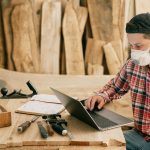If you want to master your home office setup, choosing between a top or bottom monitor mount is like selecting the perfect tool from your toolbox.
Each option offers its own set of benefits, and understanding which one suits your needs can make a world of difference.
From maximizing desk space to optimizing viewing angles, the right mount can elevate your workspace to new heights.
So, let's dive in and explore the factors that will help you make an informed decision about whether a top or bottom monitor mount is better for your home office.
Key Takeaways
- Proper chair ergonomics and posture are essential for preventing discomfort and musculoskeletal issues in a home office setup.
- A monitor mount can help optimize desk space by freeing up room for other essential items.
- Adjusting the monitor mount to suit your line of sight reduces neck and eye strain, enhancing overall work experience.
- Top mounts offer easy installation, flexibility of adjustment, and often include effective cable management systems, while bottom mounts offer streamlined installation and greater adjustability for improved visibility and ergonomic positioning.
Ergonomics and Posture
You should prioritize your ergonomics and posture when deciding on a top or bottom monitor mount for your home office. Proper chair ergonomics are essential to prevent discomfort and musculoskeletal issues.
When considering a monitor mount, ensure that it allows you to maintain a neutral posture, with your feet flat on the floor, knees at a 90-degree angle, and your monitor at eye level. This setup helps to reduce strain on your neck, shoulders, and back, promoting better long-term health and productivity.
For those using standing desks, it's equally important to maintain good posture. A top monitor mount can be beneficial in this case, ensuring that the screen is at eye level even when standing. This helps to prevent hunching or tilting of the head, promoting a more natural and comfortable position while working.
Whether you opt for a top or bottom monitor mount, remember that proper chair ergonomics and posture are the foundation of a healthy and productive home office setup. Prioritizing these factors won't only enhance your comfort but also contribute to your overall well-being and efficiency.
Desk Space Optimization
Optimize your desk space by choosing a monitor mount that allows for maximum flexibility and efficient use of your work area.
A top or bottom monitor mount can help in space saving, as it frees up the surface of your desk for other essential items such as documents, stationery, and personal effects. By lifting the monitor off the desk, you create more room to work comfortably.
Additionally, a well-designed mount will also include features for cable organization, ensuring that your desk remains neat and clutter-free. This is especially important for a home office setup, where space is often limited, and maintaining a tidy workspace is crucial for productivity.
When selecting a monitor mount for desk space optimization, look for one that offers adjustable arms or a swivel function. This will allow you to position your monitor exactly where you need it, maximizing your available workspace.
Furthermore, consider a mount with built-in cable management to keep cords organized and out of the way. By incorporating these space-saving and cable organization features, you can create an efficient and ergonomic work environment in your home office.
Viewing Angles and Comfort
When setting up your home office, it's important to consider ergonomics for better posture and flexibility in viewing angles.
By adjusting the monitor mount to suit your line of sight, you can reduce neck and eye strain, ultimately enhancing your comfort and productivity.
Prioritizing viewing angles and comfort can make a significant difference in your overall work experience.
Ergonomics for Better Posture
To achieve better posture and viewing comfort while working in your home office, consider the ergonomics of your monitor mount.
Start by ensuring proper lumbar support and seating position. Your chair should support the natural curve of your lower back, promoting good posture and reducing strain.
Position your monitor at eye level, about an arm's length away, to minimize neck strain.
Additionally, maintain wrist support and proper keyboard placement. Your wrists should be straight and level with your keyboard to prevent discomfort and strain.
A monitor mount that allows for easy adjustment of height and tilt can greatly contribute to your overall comfort.
Flexibility in Viewing Angles
Achieving comfortable viewing angles is essential for reducing eye strain and enhancing productivity while working in your home office. By adjusting the tilt and rotation of your monitor, you can ensure that the screen is always at an optimal position for your line of sight, complementing the ergonomic setup you have established for better posture and overall comfort.
When considering mounting options, look for ease of installation to ensure a hassle-free setup. Adjustable angles offer ergonomic benefits, allowing you to customize the position of your monitor to match your specific needs. This flexibility not only reduces strain on your eyes and neck but also enhances your overall comfort, ultimately leading to a more productive and enjoyable work experience in your home office.
Reducing Neck and Eye Strain
Reducing neck and eye strain is crucial for maintaining comfort and productivity in your home office setup. To achieve this, invest in ergonomic chairs with proper neck support. Your chair should allow you to sit with your feet flat on the floor, knees at a 90-degree angle, and your eyes level with the top of the monitor.
Additionally, consider using monitors with blue light filters to minimize eye strain. Position the monitor at arm's length and slightly below eye level, reducing the need to tilt your head upwards.
Remember to take short breaks to rest your eyes and stretch your neck and shoulders. By implementing these adjustments, you'll create a comfortable and healthy workspace, minimizing the risk of neck and eye strain.
Installation and Adjustability
When it comes to installing and adjusting your monitor mount, you'll want to weigh the benefits of a top mount versus the advantages of a bottom mount.
Each option offers different levels of adjustability, so consider your specific needs and preferences.
Comparing the adjustability of top and bottom mounts will help you determine which one is better suited for your home office setup.
Top Mount Benefits
You'll appreciate the ease of installation and the flexibility of adjustment with a top monitor mount in your home office.
Top mounts offer a hassle-free setup, allowing you to quickly install your monitor without the need for complex tools or extensive assembly.
Additionally, the adjustable features of a top mount provide you with the freedom to position your monitor at the perfect height and angle for your specific needs. This adaptability ensures ergonomic comfort and optimal viewing, reducing strain on your neck and eyes during long work sessions.
Moreover, top mounts often include effective cable management systems, keeping your workspace organized and free from tangled cords.
With these benefits, a top monitor mount offers convenience and customizable functionality, enhancing your home office environment.
Bottom Mount Advantages
For a more streamlined installation and greater adjustability, a bottom monitor mount offers a convenient solution for your home office setup.
When it comes to installation, a bottom mount is usually easier to set up compared to a top mount. With a bottom mount, you can simply attach it to the desk or work surface without the need for additional reinforcement or complicated adjustments. This simplicity not only saves time but also reduces the risk of installation errors.
In terms of adjustability, a bottom mount provides improved visibility and ergonomic positioning for your monitor. You can easily adjust the height, tilt, and swivel of your monitor to achieve the most comfortable and efficient viewing angles.
Additionally, bottom mounts often include integrated cable management systems, keeping your workspace tidy and organized.
Adjustability Comparison
To compare the adjustability of top and bottom monitor mounts, consider the ease of installation and the range of ergonomic adjustments available.
Bottom mounts often offer easier installation options, as they can be attached directly to the desk, providing a sturdy base for the monitor. This can be particularly beneficial if you frequently change your monitor setup.
Additionally, bottom mounts often provide superior cable management, keeping your workspace organized and free from clutter.
When it comes to ergonomic adjustments, both top and bottom mounts can offer a wide range of movement, but bottom mounts may provide slightly more flexibility due to their direct attachment to the desk. This can allow for more precise adjustments to suit your individual preferences and improve overall comfort during long work hours.
Cable Management Solutions
Your home office's cable management solutions play a crucial role in maintaining a tidy and organized workspace. Effective cable organization is essential for creating a professional and efficient environment. Investing in wire management solutions can help you keep unsightly cords out of sight, making your desk cable management a breeze.
There are various cable organization solutions available, such as cable trays, clips, sleeves, and cable boxes, designed to keep your workspace clutter-free. These solutions not only improve the aesthetics of your home office but also prevent tripping hazards and make it easier to clean your workspace.
When considering desk cable management, opt for solutions that cater to your specific needs. For instance, if you have multiple devices, a cable tray or cable box can help gather and conceal the various cords. Alternatively, cable clips and sleeves are ideal for organizing and securing individual cords along the edges of your desk.
Monitor Stability and Security
Achieving monitor stability and security is essential for creating a reliable workspace in your home office. To ensure your monitor is secure and stable, there are several key factors to consider:
- Monitor Stability: Look for a mount that offers sturdy construction and a weight capacity suitable for your monitor. This will prevent wobbling or tipping, providing a stable viewing experience.
- Cable Management: Opt for a mount with integrated cable management to keep wires organized and out of the way. This not only enhances the aesthetics of your workspace but also reduces the risk of tripping hazards and damage to cables.
- Security Features: Consider mounts with security locks or mechanisms to prevent unauthorized removal of the monitor. This is especially important in shared or public spaces to safeguard your equipment.
- Installation: Follow proper installation guidelines to ensure the mount is securely attached to the desk or wall. This will further enhance stability and security, preventing any accidental dislodging.
- Regular Maintenance: Periodically check the mount and ensure all components are tight and secure. This proactive approach can prevent potential stability issues and maintain a secure setup for your monitor.
Flexibility for Multi-Monitor Setups
How can a top or bottom monitor mount provide flexibility for multi-monitor setups in your home office?
When setting up a multi-monitor workspace, the positioning and arrangement of screens are vital for optimal productivity. A top monitor mount allows for easy screen positioning, enabling you to adjust the height, tilt, and rotation of each monitor independently. This flexibility is crucial for creating a customized desk setup that suits your ergonomic needs and enhances your workflow. Additionally, a top mount facilitates efficient cable organization, keeping the workspace tidy and free from clutter.
On the other hand, a bottom monitor mount offers its own set of advantages for multi-monitor setups. It allows for seamless monitor arrangement, enabling you to align the screens precisely for a cohesive and streamlined display. This is particularly beneficial when working with multiple monitors for tasks such as video editing, graphic design, or financial analysis, where a continuous and uninterrupted screen layout is essential.
Both top and bottom monitor mounts provide the flexibility needed for multi-monitor setups, allowing you to create an ergonomic and efficient home office environment tailored to your specific requirements.
Aesthetics and Workspace Design
To enhance the aesthetics and design of your workspace, consider how a top or bottom monitor mount can impact the overall look and feel of your home office. The placement of your monitor can significantly influence the organization and visual appeal of your workspace.
When deciding between top and bottom monitor mounts, here are some key factors to consider:
- Ergonomics: The monitor mount you choose can contribute to a more ergonomic workspace, reducing strain on your neck and eyes.
- Space Optimization: Consider how the monitor mount will affect the overall layout and space utilization in your home office.
- Cable Management: Different monitor mounts offer varying levels of cable management, impacting the cleanliness and organization of your workspace.
- Aesthetics: The style and design of the monitor mount can complement or detract from the overall aesthetic of your workspace.
- Flexibility: Evaluate how the monitor mount will affect the flexibility and adaptability of your workspace design.
Frequently Asked Questions
What Are the Most Common Types of Top and Bottom Monitor Mounts Available in the Market?
When it comes to top and bottom monitor mounts, the most common types on the market offer various pros and cons. Their installation processes differ, as do their costs, space-saving designs, and cable management solutions.
Are There Any Specific Weight or Size Limitations for Top or Bottom Monitor Mounts?
When choosing between a top vs bottom monitor mount, consider weight and size limitations. Top mounts are better for heavier monitors, while bottom mounts are ideal for smaller ones. Check the specifications to ensure your monitor is compatible.
Can Top or Bottom Monitor Mounts Be Easily Adjusted for Different Users or Preferences?
You can easily adjust top or bottom monitor mounts to fit your ergonomic preferences. Both options offer flexibility and provide ergonomic benefits. Consider your specific needs and workspace setup to determine which mount will best suit your requirements.
Are There Any Specific Compatibility Requirements for Top or Bottom Monitor Mounts With Different Types of Desks or Workstations?
Ensure desk compatibility when selecting a top or bottom monitor mount. Consider workstation requirements and ergonomic benefits. Be mindful of potential installation challenges. Assess your setup to make an informed decision that suits your needs.
Are There Any Additional Accessories or Features That Are Commonly Included With Top or Bottom Monitor Mounts?
When setting up a monitor mount, consider the installation process and cable management. Many mounts come with tools for easy installation and features like built-in cable management to keep your workspace organized and professional.





